Address Arrington SG8 0BW, UK | Phone +44 1223 206000 | |
 | ||
Hours Closed now Monday11AM–5PMTuesday11AM–5PMWednesday11AM–5PMThursday11AM–5PMFriday11AM–5PMSaturday11AM–5PMSunday11AM–5PMSuggest an edit Similar Anglesey Abbey, Wimpole Home Farm, Wicken Fen, Audley End House, Wrest Park Profiles | ||
Wimpole estate 25 june 2014
Wimpole Estate is a large estate containing Wimpole Hall, a country house located within the Parish of Wimpole, Cambridgeshire, England, about 8 1⁄2 miles (13.7 kilometres) southwest of Cambridge. The house, begun in 1640, and its 3,000 acres (12 km2) of parkland and farmland are owned by the National Trust and are regularly open to the public. Wimpole is the largest house in Cambridgeshire.
Contents
- Wimpole estate 25 june 2014
- Wimpole estate national trust with dji phantom 4 litchi mission
- History
- The grounds
- Listed buildings
- Community use
- References
Wimpole estate national trust with dji phantom 4 litchi mission
History
Sited close to the great Roman road, Ermine Street, Wimpole was listed in the Domesday Book of 1086. At that time there was a moated manor house set in a small 81 hectares (200 acres) deer-park. Situated to the north and south of this were three medieval villages: Bennall End, Thresham End and Green End.
The house was held by the Chicheley family for over 250 years. The last of this family to hold the house was the politician Thomas Chicheley, who was responsible for the "new" house that was completed in 1650. He enjoyed the house for 36 years until, weighed down by financial problems, he was forced to sell to Sir John Cutler. In 1689, Sir John gave it as a marriage settlement to his daughter Elizabeth and her husband Charles Robartes, 2nd Earl of Radnor. On the death of Elizabeth in 1697, without an heir, the estate passed to Edmund Boulter, nephew of Sir John Cutler. In 1710 it was in the possession of John Holles, 1st Duke of Newcastle-upon-Tyne, who left it to his daughter Lady Henrietta Cavendish Holles upon his death the following year. Upon Henrietta's marriage, in 1713, it became the possession of her husband Edward Harley, 2nd Earl of Oxford and Earl Mortimer. In 1740, Edward sold Wimpole to the Earl of Hardwicke, to pay his debts. The Earls of Hardwicke held it until it passed into the hands of Thomas Agar-Robartes, 6th Viscount Clifden, and then his son, Francis Agar-Robartes, 7th Viscount Clifden.
In 1938, Capt. George Bambridge and his wife, Elsie, daughter of Rudyard Kipling, purchased it after having been tenants since 1932. They used the inheritance left to them by her father, and the royalties from his books, for the long-needed refurbishment of the house and grounds. The final chapter of Wimpole as an owner-occupied residence was closed in 1976 when Elsie died, leaving the property to the National Trust.
Over the centuries many notable architects have worked on it, including James Gibbs (between 1713 and 1730), Henry Flitcroft (around 1749), John Soane (1790s), and H. E. Kendall (1840s). There are decorative schemes by the painter James Thornhill (1721).
The grounds
Wimpole Hall's grounds were laid out and modified by landscape designers such as George London and Henry Wise (1693–1705), Charles Bridgeman (1720s), Robert Greening (1740s), "Capability" Brown (1767), and Humphry Repton (1801–1809).
Bridgeman's formal grand avenue sweeps away from the south front of the house for two and a half miles, in contrast with the remainder of the park which was "naturalised" by Capability Brown. The North Park is particularly attractive with its belts of woodland, gentle rolling hills with individual trees and clumps of trees. The central feature of the North Park is the Gothic Tower and the restored lakes in the valley below. In the grounds are a chain of lakes (1695–1767), St Andrew's church (1749), Wimpole's Folly (the false Gothic Tower; 1768), a home farm (1792), a walled garden (18th century), and a stable block (1851).
Listed buildings
The Wimpole Park Estate contains a number of listed buildings and structures. Wimpole Hall is Grade I listed, and the estate itself is Grade I listed on the Register of Historic Parks and Gardens. The entrance gates and piers at the west entrance to the hall are listed Grade II, and the stable block is listed Grade II*.
In the gardens, a group of five vases and a sculptural group of Samson and Philistine are listed Grade II, as are the steps to the west of the hall and the wall and railings to the south. On the edge of the ornamental gardens the Ha-ha to the north west and to the north are both listed Grade II. The Wimpole's Folly castle on the estate is listed Grade II*.
The walled garden and the gardener's cottage on the north side of the walled garden are both listed Grade II, as is the game larder to the north east of the hall.
Community use
Like many other estates managed by the National Trust, a range of organised events and less formal access arrangements now use Wimpole Park. In 2013, a national partnership between the Trust and Parkrun led to the establishment of a weekly 5 km run around the park, currently enjoyed by over 200 participants every Saturday at 9am.
